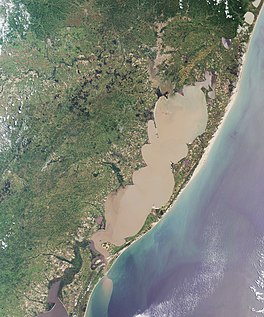Lagoa dos Patos (Portuguese pronunciation: [laˈɡoɐ dus ˈpatus]; English: Ducks' Lagoon) is the largest lagoon in Brazil and the largest coastal lagoon in South America.[2] It is located in the state of Rio Grande do Sul, southern Brazil. It covers an area of 10,100 km2 (3,900 sq mi),[2] is 180 miles (290 km) long and has a maximum width of 44 miles (71 km).[4]
| Lagoa dos Patos | |
|---|---|
 Lagoa dos Patos from satellite | |
| Location | Brazil |
| Coordinates | 31°06′S 51°15′W / 31.100°S 51.250°W |
| Type | lagoon |
| Primary inflows | Jacuí-Guaíba and Camaquã River |
| Primary outflows | São Gonçalo Channel |
| Catchment area | 201,626 km2 (77,848 sq mi)[1] |
| Max. length | 180 miles (290 km) |
| Max. width | 44 miles (71 km) |
| Surface area | 10,100 km2 (3,900 sq mi)[2] to 10,360 km2 (4,000 sq mi)[1] |
| Average depth | 6 m (20 ft)[3] |
Lagoa dos Patos is separated from the Atlantic Ocean by a sandbar about 5 miles (8.0 km) wide. The Jacuí-Guaíba and Camaquã Rivers empty into it, while the navigable São Gonçalo Channel, which enters Lagoa dos Patos near the town of Pelotas, connects Lagoa dos Patos to Lagoa Mirim to the south.[2] The Rio Grande, at the south end of Lagoa dos Patos, forms the outlet to the Atlantic.[2]
This lagoon is evidently the remains of an ancient depression in the coastline shut in by sand bars built up by the combined action of wind and current. The shallow lagoon is located at sea level and its waters are affected by the tides, normally they are brackish only a short distance above the Rio Grande outlet,[2] but this can vary a lot. In droughts and favorable winds, sea water can be carried up to almost the entire lagoon.[5]
The lagoon's largest and most fertile island is the Ilha dos Marinheiros, which is located near the eastern shore. The island is geopolitically part of the municipality of Rio Grande.[citation needed]
The lagoon hosts a rich biodiversity, including fresh- and brackish water fish, and water birds such as black-necked swan, coscoroba swan and Chilean flamingo.[2] Top predators from ocean ecosystem, notably common bottlenose dolphins, can sometimes be seen at Lagoa dos Patos[6][7] and exceptionally southern right whales are found at the Rio Grande outlet.[8][9]

Geography
The lagoon has average length and width of 290 km (180 mi) and 40 km (25 mi), respectively. It covers a surface of 10,100 km2 (3,900 sq mi),[2] slightly smaller than Jamaica, and occupies nearly one third the area of the Coastal Plain of the state of Rio Grande do Sul. The lagoon roughly runs NE-SW, with an average depth of almost 6 m (20 ft), and mean tidal amplitude of 0.45 m. At its southern end, near Rio Grande city, the only inlet of Lagoa dos Patos has a mean discharge of 4,800 m3/s (170,000 cu ft/s). Sea water penetrates northwards into the lagoon up to 200 km during exceptional conditions favored by southern winds, low water levels in the lagoon, and spring tides. The lagoon receives freshwater from about 201,626 km2 (77,848 sq mi),[1] mostly from the catchment basin of the Guaíba River system, whose mouth is located in Porto Alegre - the Jacuí Delta - at the northwestern end of the lagoon. The coastal plain bordering the lagoon typically has elevations that reach up to 6 m, mostly consisting of sandy deposits interrupted by small inlets. Those spits rise in average 1 m above the mean water level and on the west margin of the lagoon their submerged part extends about 15 km into the water body.[3]
Tributaries
Major tributaries of the Lagoa dos Patos basin:[10]
Towns and cities on coast

References

